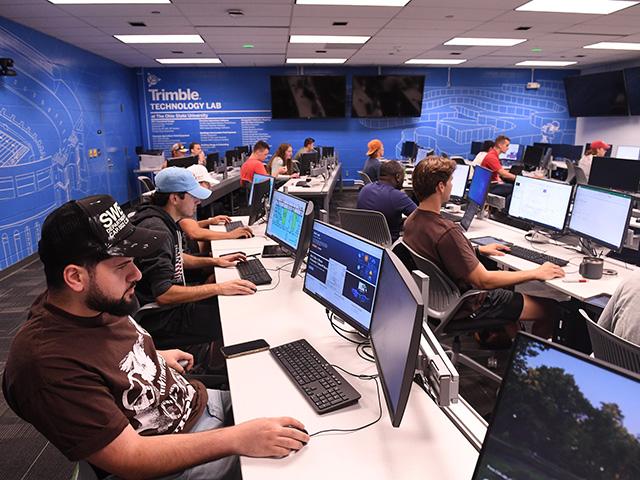Trimble, Ohio State Open Ag Tech Labs
Ohio State University Shows Students an Ag Technology Future in Trimble Technology Labs
Trimble and Ohio State University (OSU) are opening state-of-the-art Trimble Technology Labs within the university's College of Food, Agricultural and Environmental Sciences (CFAES). Trimble is an industrial technology company headquartered in Westminster, Colorado.
The new Trimble Technology Labs, based on Ohio State's campus in Columbus and at its Agricultural Technical Institute in Wooster, provide students with hands-on access to Trimble's construction and geospatial technologies and are the first Trimble Technology Labs to include its agricultural solutions. The Ag Tech Institute is one of the nation's largest two-year-degree-granting entities focused on agriculture.
To date, Trimble has committed $40 million to its technology partnership with Ohio State. In this first year of operation, more than 1,000 students will have access to the labs dedicated to training the next generation of agriculture and construction professionals.
The ag labs are built around workstations that simulate the use of Trimble agriculture hardware and software in the classroom, including machine guidance and control, assisted steering, field leveling and water management systems. Moreover, the Ohio State University Extension will tap into the labs' resources to re-equip farmers and agricultural professionals with ever-improving technologies that can boost productivity and efficiency.
"In recent years, farming and construction industries have faced crucial labor shortages and skilled labor gaps," said Jim Chambers, vice president and general manager of Trimble's agricultural business. "With the added technology in these labs, we're looking to not only attract the next generation of agriculture and construction professionals, but we hope to attract a whole new subset of students looking for technology careers that may not have realized a career in agriculture or construction could be for them."
P[L1] D[0x0] M[300x250] OOP[F] ADUNIT[] T[]
Scott Shearer, professor and chair of CFAES at OSU, wholly agrees with that goal. It was common in the past, he said, for students enrolling in agricultural studies at schools such as OSU to come from an agricultural background. But that group is shrinking.
"One of our challenges is we get people into (Ohio State) agriculture programs from outside, and they may have grown up in a small town or even an urban area," Shearer said. "They haven't had that exposure to agricultural production. They don't have a lot of seat time on equipment or understand the function of the equipment."
The labs are designed to overcome those obstacles. They are shop-sized spaces equipped with Trimble technology. Trimble Labs aim to address a shortfall in technical expertise that will be -- and already is -- important to industry in general and food production and agriculture in particular.
Chambers' message to students is to be open to technological change and technology opportunities, such as data analytics and artificial intelligence, machine learning, and geo-mapping and modeling, he said.
"We've talked about data for years and years in agriculture," Chambers said, "and we have massive amounts of data. But we don't have data in a format that is truly accessible and usable. We've focused on managing variability in the field. And that's really been the foundation for precision ag today. But the next front in precision ag is managing the stuff that varies very frequently: things like weather and pests. You can't just wait for that to happen and then react. You may not have enough time to react. You have to be able to model, to create replicas ... to create predictive analytics."
The labs give students access to Trimble's most cutting-edge technologies. "First and foremost, we hope (the labs) will drive curiosity and possibilities," Chambers said. "These are students who are going to come into the agriculture world and hopefully spend 30-plus years in their careers. We want them to see the possibilities about what could be next."
OSU looks for students who are ready for the challenge. "A lot of these students get pretty excited about technology, (about how) artificial intelligence is going to be used in the livestock sector," Shearer said. "That whole industry is poised for a pretty significant transition. We're beginning to talk about precision livestock farming. And I think some of the robotics being used in the dairy industry is the best example of what's going to happen in terms of the transformation of that animal industry. Robotic milkers. Robotic feed carts. There is so much of that industry that will benefit from digitization, which in part is being driven by labor cost and labor availability."
The key, Shearer said, is getting the word out to students with and without ag backgrounds.
"I go out and I talk about technology and agriculture. And (people) don't realize what's going on in agriculture. They still have the view of production agriculture, something stuck back in the 1940s, 1950s, like the 'Lassie' TV series. Our biggest challenge is getting the word out to students who want to be involved in agriculture and let them know there are technology-driven career opportunities in agriculture."
Dan Miller can be reached at dan.miller@dtn.com
Follow him on X, formerly known as Twitter, @DMillerPF
(c) Copyright 2024 DTN, LLC. All rights reserved.




